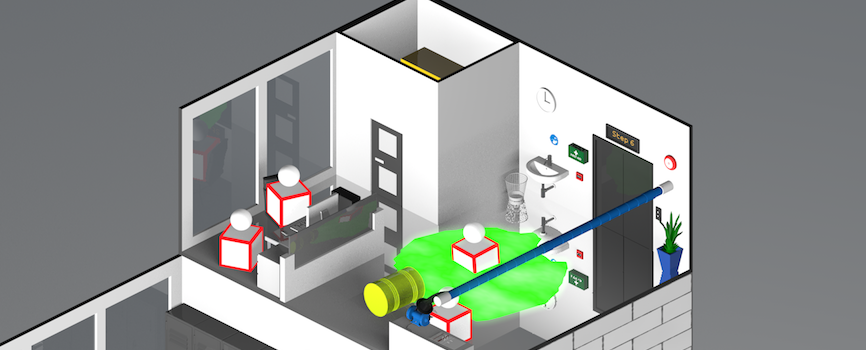Creating Boundaries when Remote Working
Posted 5 years ago

A significant difference between remote working and working from the “office” is the lack of clear boundaries. When you travel to an office every day, home and work are two distinctly different places separated by a commute; there’s a clear beginning and end to your work day.
As a remote worker, it’s crucial that YOU create your own boundaries and stick to them as much as possible. There are three kinds of boundaries which we’re going to look at: physical, mental, and social.
Physical Boundaries
Let’s start with physical boundaries. The goal of setting physical boundaries is to recreate the real-world divide between your home and your place of work. The best way to achieve this is to physically separate your workspace from your non-workspace. Try working in a spare room, a back bedroom, a loft conversion, a basement, or any other space where you wouldn’t usually spend your non-working hours.
If this isn’t possible, however, then try to make your workspace look and feel different. Rearrange the furniture, place a few photos on your desk, and when you finish for the day store your laptop and any paperwork away and out of sight. It’s best to separate your work and home equipment too; the laptop you use for work shouldn’t be the one you use to browse the internet in the evenings.
Mental Boundaries
Mental boundaries are tricks that you use to help your brain get started in the morning and to switch off at the end of the day. The most important boundary you need to establish is a firm starting line and finishing post for your day; something like the typical 9 – 5, but make it work for you. You could even split your working day into chunks, for example, if you need to pick the kids up from school at 3, you might work from 9 to 2.30 and then again from 5 to 7.30. Whatever you decide, make sure you agree your hours with your manager so that you can be available when you’re needed.
At the beginning of the day, to help your brain focus and be ready for work, give yourself some kind of cue. You could start the day by always listening to a particular song, by drinking a cup of coffee, or going for a walk, for example. Just something which tells your brain “It’s time to get going”. It may also help to “get dressed for work”, you don’t have to wear a suit and tie but just changing into something you didn’t wear to bed last night can make you feel motivated and ready to work.
And, when it comes to the end of the day, it can be tempting to judge your work by asking yourself “Did I finish everything today?”. Often, you won’t finish everything by the end of the day and you’ll simply pick up where you left off tomorrow, but measuring the worth of your whole day’s work by what you actually got finished can tempt you into a few more hours work here and there, until you find yourself sat at your desk at 1am finishing a report you could have left until the morning. Instead of asking “Did I finish everything today?” ask yourself “Did I work to the best of my ability today?”. If the answer is “Yes”, log out, switch off, and end your day satisfied. If the answer is “No”, think about why that might be and ask yourself what you could do differently tomorrow. And then log out, switch off, and end your day having learned something.
Social Boundaries
Social boundaries are the ground rules you need to establish in order to effectively manage your work/life balance. Your colleagues and your manager need to understand that remote working brings its own particular challenges and, particularly if you have children in the house, that there will be some distractions and obligations which wouldn’t happen in the office. Similarly, the people you live with need to understand that you can’t always be available and that there will be times when you need to focus without being disturbed.
For the people you work with, it’s important that you establish ground rules on your availability and response time. Discuss with your manager exactly when they expect you to be available and, if it’s possible, suggest that they allow you periods of unavailability so that you can really focus without being worried about distractions from work.
And, if they do contact you, they need to know when to expect a reply. How long will you take to return their missed call or to respond to their email, text, or instant message? Setting out clear ground rules on availability and response times helps manage your colleagues’ expectations and it also allows you to plan your daily schedule more effectively.
The ground rules you set at home are different depending on who you live with. If you live with adults, setting ground rules is as easy as having a conversation. Tell them your needs, ask them about their needs, and find some common ground that works for the both of you. Where it gets tricky is when children are involved. Use the rules you set with your co-workers as a guide; if you need to be available to your co-workers between 11am and 2pm, for example, then make this “Quiet Time” at home.
You could try splitting your day into periods of low-focus and high-focus; perhaps for the first few hours in the morning and the last few hours in the evening, you take care of some low-focus tasks and make yourself semi-available to your family if they need you. Then the rest of your day can be dedicated to high-focus tasks without you being disturbed. It could even help to change your physical location during different periods of the day, perhaps your low-focus periods take place at the kitchen table and your high-focus periods in your home office.
Whatever ground rules you set, be open-minded and respect other people’s needs, and ask that they respect yours.
Effective Remote Working
Our Effective Remote Working Training is suitable for anyone that permanently or temporarily works from home. As well as the videos above, the course includes information about the importance of communication, how to set up a productive workspace and how to manage distractions.
Why not get started with a free trial today?


James Kelly
Senior Scriptwriter
Related articles



Opt-in to our newsletter
Receive industry news & offers